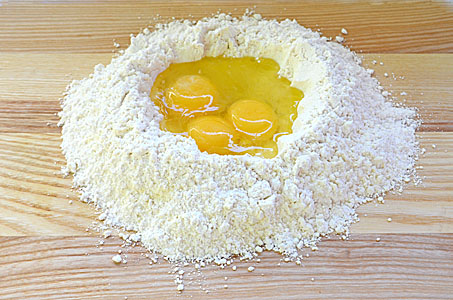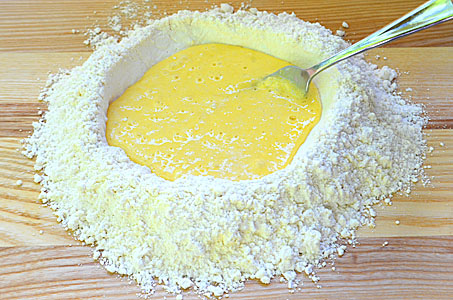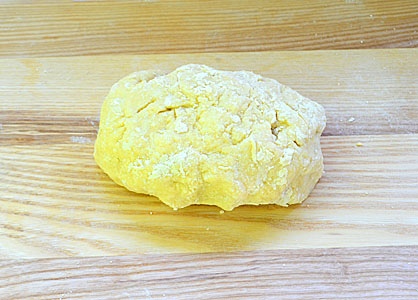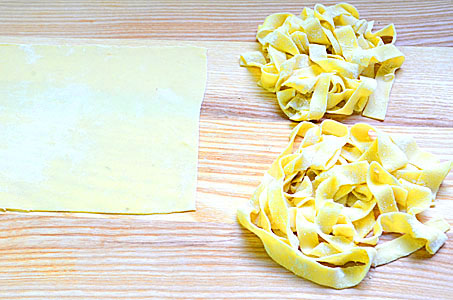Making fresh pasta is not as hard as it seems if you have the right equipment. I use my Kitchen Aid mixer with a pasta roller attachment – it takes the headache out of cranking that ole pasta machine all day. It cranks out pasta in short time: otherwise, it can be a long drawn out affair. I use this recipe to make everything from ravioli to farfalle.
The first secret to making really great pasta dough is the flour. I use a mixture of all-purpose flour and Durum flour. Durum flour and Semolina are traditionally used for making pasta. Durum flour has a finer texture then Semolina, which are both made from Durum wheat. Semolina can be used in place of Durum flour in this recipe, but it will give your pasta a gritty texture. My remedy for this is to run the dry Semolina in a food processor for several minutes until it has a finer consistency. You can also use only all-purpose flour, though I find that it results in a rather anemic pasta. Some people compensate for this by adding additional eggs, but it makes the pasta taste more like egg noodles in my opinion. For the best tasting pasta, Durum flour gets my vote. I confess that it isn’t easy to find durum flour, but you can order it online if you are serious about your pasta. It’s also great to use in bread and pizza dough.
The second secret to making great pasta dough is kneading it well. You have to give the pasta a good hard knead! Oh, and try not to add too much water. Good luck on your pasta making endeavor.
FRESH PASTA DOUGH
(Pasta Frisca o Pasta Fresca)
Difficulty Rating: Medium
Makes approximately 1 pound.
INGREDIENTS:
1 1/3 cups all-purpose flour
2/3 cup Durum flour
1/2 teaspoon salt
2 large eggs plus 1 large egg yolk
1 1/2 teaspoons olive oil
2-4 tablespoons water
In a medium size bowl, mix the flours and salt. Place the flour into a mound on a board or countertop. Make a large depression in the flour. Place the eggs, olive oil, and 2 tablespoons of the water into the depression.
Using a small fork, beat the eggs first. Slowly begin adding in the surrounding flour, incorporating as much of the flour as possible.
Use your hands to gather and mix in the remaining flour. Add remaining water, if necessary, 1 tablespoon at a time to get a firm dough.
Knead the dough for 8 to 10 minutes, until smooth and elastic. Wrap in plastic wrap and refrigerate for at least one hour.
INSTRUCTIONS BY HAND: Have ready a floured tablecloth to lay the pasta out on to prevent it from sticking. Place the dough on a floured board or countertop. Using a rolling pin, roll out the dough until thin and cut into desired shape and place on tablecloth.
Pasta noodles, fettucine, or spaghetti can be placed in small stacks. Use additional flour to prevent pasta from sticking together. All other pasta should be spread out so they are not touching.
INSTRUCTIONS USING A PASTA MACHINE: Have ready a floured tablecloth to lay the pasta out on to prevent it from sticking. Divide dough into 4 equal pieces. Flour one piece of the dough. Keep the remaining dough covered with plastic wrap so it doesn’t dry out.
Flour the dough and flatten out initially with a rolling pin to 1/4-inch thickness. This prevents the dough from being too thick and getting chewed up by the pasta machine. Run dough through the first setting of the pasta machine. Fold dough in half, lightly flour and place through again. Repeat this step 5 or 6 times through the first setting until pasta is smooth and elastic. Lightly flour and run through each successive setting until desired thickness is achieved. Lay the pasta sheet on the tablecloth. Repeat with remaining pieces of dough. Cut pasta into desired shape and place on a floured tablecloth. Pasta noodles, fettucine, or spaghetti can be placed in small stacks. Use additional flour to prevent pasta from sticking together. All other pasta should be spread out so they are not touching.
STORAGE TIP: Storing fresh pasta in the refrigerator is not recommended. If you are not going to cook the pasta the same day, you can let it air dry completely for several hours. Place in plastic storage bags or containers and freeze up to 3 months. It will still retain its fresh taste. Do not defrost before cooking. Plunge immediately into boiling salted water.
STORAGE TIP FOR FILLED PASTA: To store filled pasta such as ravioli or tortellini, place in a single layer on a parchment lined or floured baking sheet and immediately place into the freezer. When completely frozen place in single layers, separated by parchment paper or plastic wrap, in an air-tight storage container. Do not defrost before cooking. Plunge immediately into boiling salted water.






